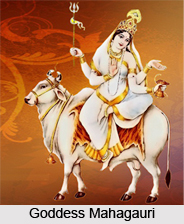 Goddess Mahagauri is the eight form of Goddess Durga among the Nava Durga. She is worshipped on the eighth day of Navaratri. Mahagauri means pure and clear ray of lightning that lights up the universe. Goddess Durga manifested herself into the form of Mahagauri to liberate the people and gods from the atrocities of the demons.
Goddess Mahagauri is the eight form of Goddess Durga among the Nava Durga. She is worshipped on the eighth day of Navaratri. Mahagauri means pure and clear ray of lightning that lights up the universe. Goddess Durga manifested herself into the form of Mahagauri to liberate the people and gods from the atrocities of the demons.
Legend of Goddess Mahagauri
According to a legend Goddess Mahagauri in the form of Goddess Parvati practised penance to obtain Lord Shiva as her husband. It is said that during the period of penance her body turned black and dull due to the accumulation of soil and dust on her body. This made her body black coloured. Lord Shiva was pleased with her devotion and accepted her as his wife. He also cleaned her body with the holy water of the Ganga River that turned her skin shining like gold. The goddess is thus, named as Mahagauri.
Attributes of Goddess Mahagauri
Goddess Mahagauri is extremely fair complexioned and can be compared to the colour of a conch shell, moon and jasmine. He clothes and ornaments are white in colour. She has three eyes and four arms. With her lower right hand she holds a trident and with her upper left hand she holds a tambourine. With the other two hands she holds the abhaya mudra and varada mudra.
Worship of Goddess Mahagauri
Goddess Mahagauri is worshipped on the Ashtami day that has a special implication among the nine divine nights of Navaratri. The goddess is worshipped with fruits, sweets, flower garlands, cloves, betel leaves, cardamom etc are offered to the goddess. The idol of the goddess is bathed with water, curd, milk and honey. Later it is with new clothes. Sandalwood, henna, vermillion and black pencil are also applied to the deity. At the beginning of the puja Lord Ganesha is worshipped. In Haridwar a temple has been constructed in Kankhal dedicated to Goddess Mahagauri. It is believed that devotees who worship the deity get relieved from all problems. All their wishes get fulfilled by the grace of the goddess. The following mantra is chanted while praying to the goddess
Hrete Vrishe Samrudha Shretambradhara Shuchi |
Mahagauri Shubham Dghyanmahadevapramodada ||




















